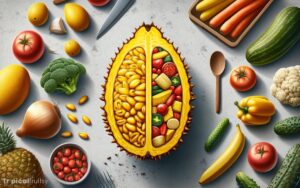How to Grow Ackee from Seed? 4 Easy Steps!
The ackee, Blighia sapida, is a tropical evergreen tree native to West Africa, renowned for its distinctive fruit that is both a culinary staple and cultural symbol in Jamaica.
Cultivating ackee from seed is a rewarding venture that requires a grasp of the tree’s growth requirements and patient attention to detail.
This guide is aimed at providing gardeners and enthusiasts with a comprehensive understanding of the process, from sourcing viable seeds to ensuring the proper conditions for germination and subsequent growth.
It will cover the essential steps, including seed preparation, soil composition, and planting techniques, as well as ongoing care for young ackee saplings.
Addressing common challenges in ackee cultivation, this text seeks to equip readers with the knowledge to nurture their own ackee trees to fruition.
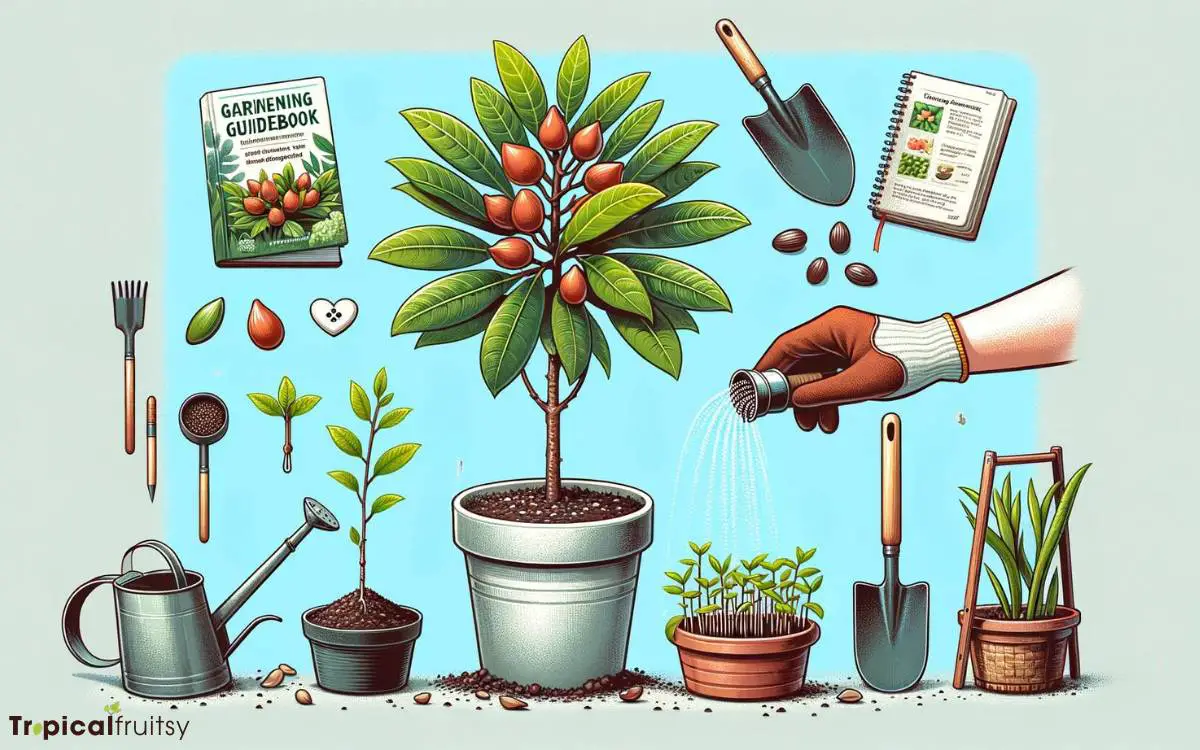
Key Takeaway
Understanding Ackee and Its Requirements

To successfully cultivate ackee (Blighia sapida) from seed, one must first comprehend the tropical plant’s specific growth conditions and care requirements.
Ackee thrives in a warm climate, typically within USDA hardiness zones 9 to 12, and requires well-drained, fertile soil with a pH ranging from 6.5 to 7.5.
Adequate watering is critical, especially during the initial growth period, but overwatering must be avoided to prevent root rot.
Full sunlight exposure is essential for vigorous growth and fruit production. Moreover, protection from strong winds and provision of ample space for the canopy to expand are necessary to facilitate healthy development.
Having established the requisite conditions for ackee cultivation, attention must now turn to the initial step in the propagation process: sourcing quality ackee seeds.
Sourcing Quality Ackee Seeds
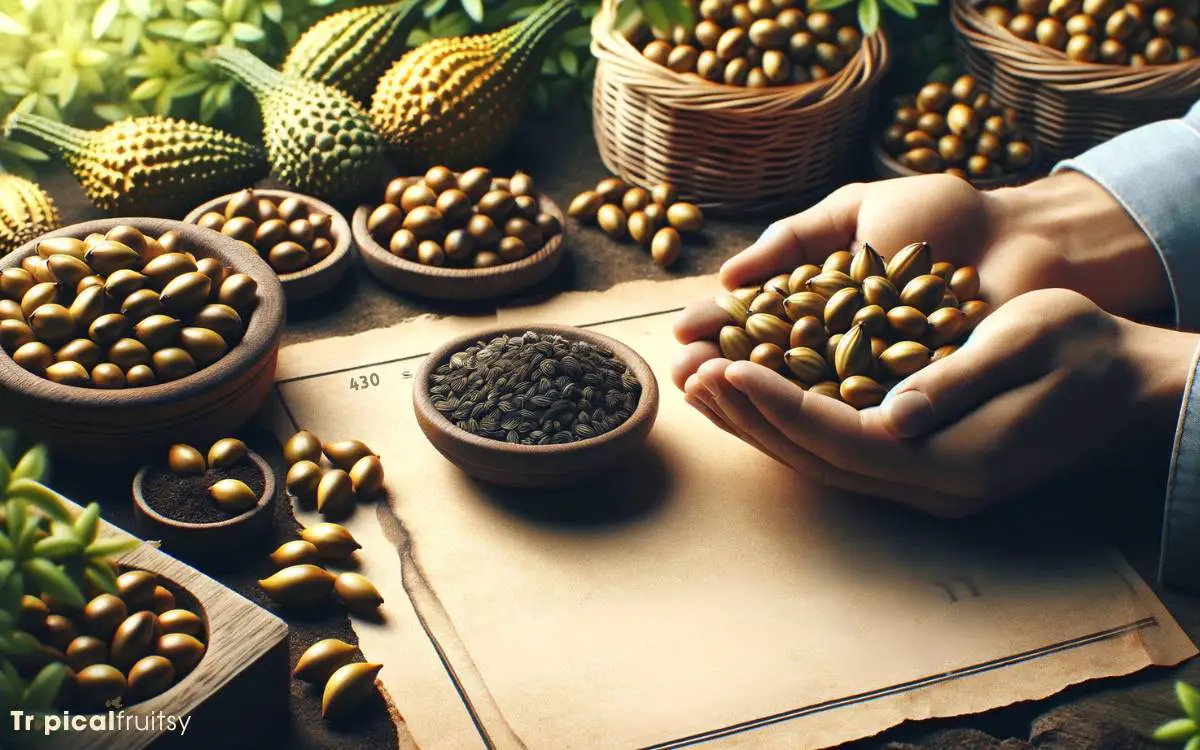
To ensure the successful cultivation of ackee (Blighia sapida), one must begin with the procurement of high-quality seeds.
The selection of seeds should be based on specific criteria, including genetic purity, physical condition, and provenance, with considerations made for the distinct advantages and potential challenges of both locally sourced and imported seeds.
Furthermore, the timing and technique of harvesting seeds from ripe ackee pods are critical to maximize viability and subsequent growth potential.
Seed Selection Criteria
Selecting viable ackee seeds is a critical first step in ensuring a successful germination and growth process for this unique fruit tree.
Quality seeds typically exhibit certain characteristics that are indicative of their potential to produce healthy plants. It is essential to examine the seeds for signs of maturity, damage, and disease before proceeding with planting.
| Criterion | Description | Importance |
|---|---|---|
| Maturity | Seeds should be taken from fully ripened fruits. | High |
| Integrity | Look for seeds without cracks or holes. | Medium |
| Size & Weight | Choose seeds that are full-sized and feel heavy. | Medium |
| Disease-Free | Ensure there are no signs of mold or decay. | High |
Local Vs. Imported Seeds
Although local seeds are often fresher and more acclimated to the growing conditions of the area, imported ackee seeds may offer a broader genetic diversity which can be beneficial for the cultivation process.
When considering the source of your ackee seeds, it is critical to assess the following factors:
- Genetic Viability: Imported seeds should come from reputable sources that ensure genetic diversity without compromising the seeds’ ability to germinate and adapt to local conditions.
- Health and Safety Standards: Ensure that imported seeds meet phytosanitary regulations to prevent the introduction of non-native pests and diseases.
- Seed Adaptability: Evaluate if the imported varieties have a proven track record of successfully adapting to your local climate and soil conditions.
Prioritizing these considerations will enhance the likelihood of a successful ackee harvest.
Harvesting Ripe Ackee Pods
Obtaining quality ackee seeds begins with the careful harvesting of several ripe ackee pods, which should only be picked once they naturally open on the tree.
This indicator of ripeness is crucial; unripe or forcibly opened ackee pods can contain high levels of hypoglycin A, a toxic compound.
The process requires precision and attention to detail to ensure the viability of the seeds for propagation.
| Criteria | Description |
|---|---|
| Pod Opening | Naturally split, revealing black seeds |
| Color | Bright red to yellow, indicating ripeness |
| Texture | Firm pods, not overly soft or waterlogged |
| Seed Condition | Glossy, plump seeds without any signs of rot |
Step 1: Preparing Seeds for Germination
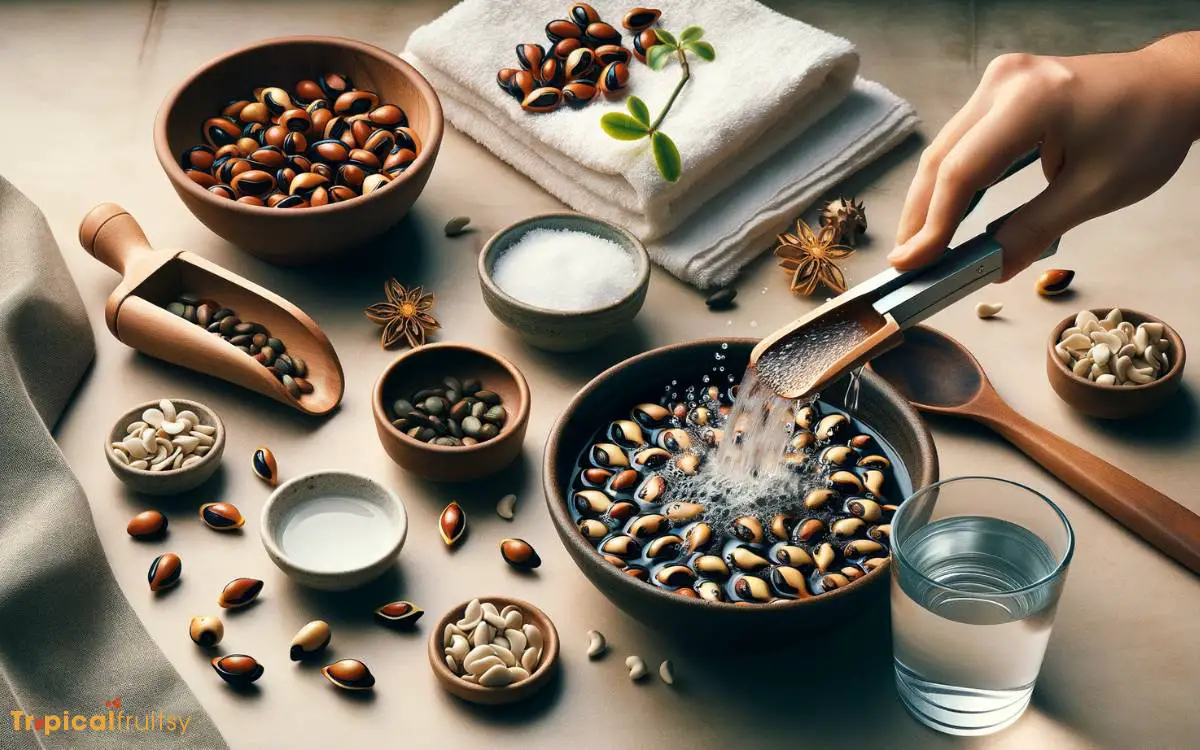
Properly preparing ackee seeds for germination regularly involves cleaning and soaking them to enhance the likelihood of successful sprouting.
To ensure the best conditions for seed viability, a meticulous approach should be adopted:
- Clean the Seeds: Remove any pulp or residue from the ackee seeds by gently scrubbing them under lukewarm water. This prevents fungal growth and disease during the germination process.
- Soak the Seeds: Submerge the cleaned seeds in room temperature water for 24-48 hours. Soaking softens the seed coat, which can improve water absorption and hasten germination.
- Stratify if Necessary: Some seeds may require cold stratification to break dormancy. This simulates the natural cool, moist conditions that seeds would encounter over winter, thereby promoting germination when temperatures rise.
Step 2: Ideal Soil and Planting Techniques
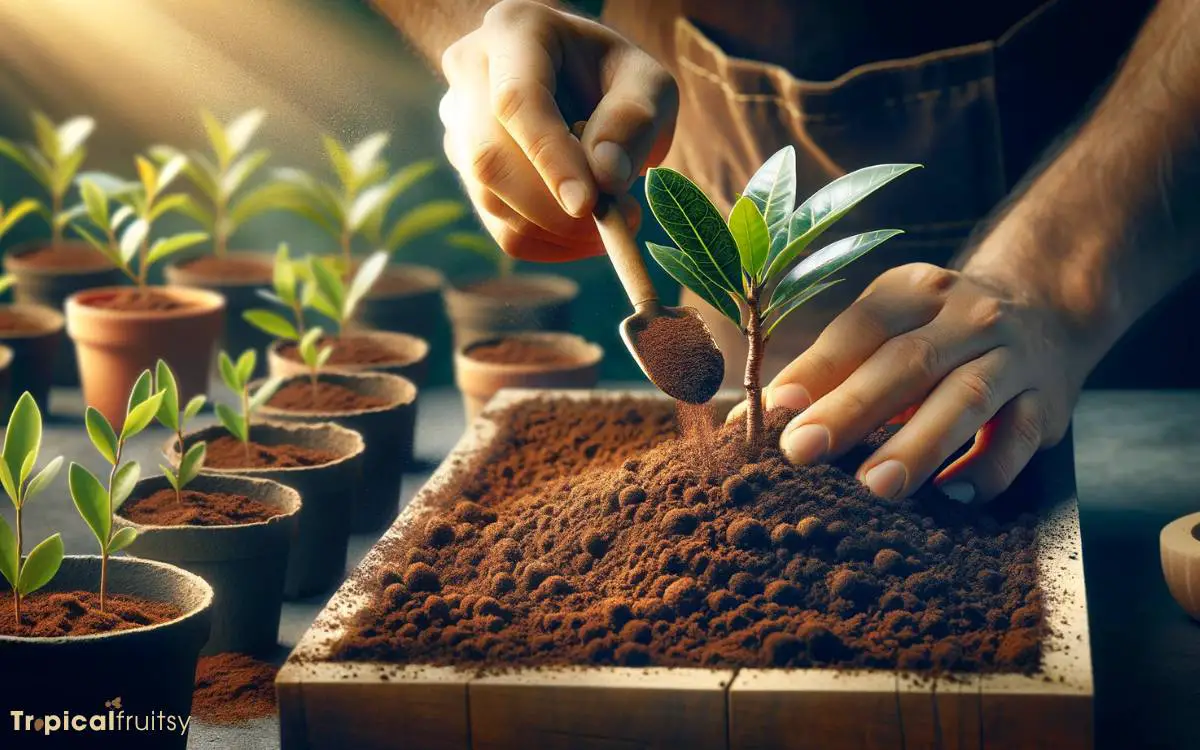
Selecting a well-draining soil rich in organic matter is pivotal when setting out ackee seeds for planting. The soil should maintain moisture without becoming waterlogged to prevent root rot, a condition detrimental to seedling viability.
Employ a soil mixture with a pH between 6.0 and 6.5, which is slightly acidic and optimal for ackee growth. Integrate compost or aged manure to enhance fertility and structure.
For planting, sow seeds at a depth of approximately twice their size; this provides sufficient coverage while allowing for adequate aeration.
Space the seeds about 20-30 cm apart to facilitate root expansion and minimize competition for nutrients.
Methodically water the soil to maintain consistent moisture levels during the germination period, which is crucial for successful seedling establishment.
Step 3: Caring for Young Ackee Saplings
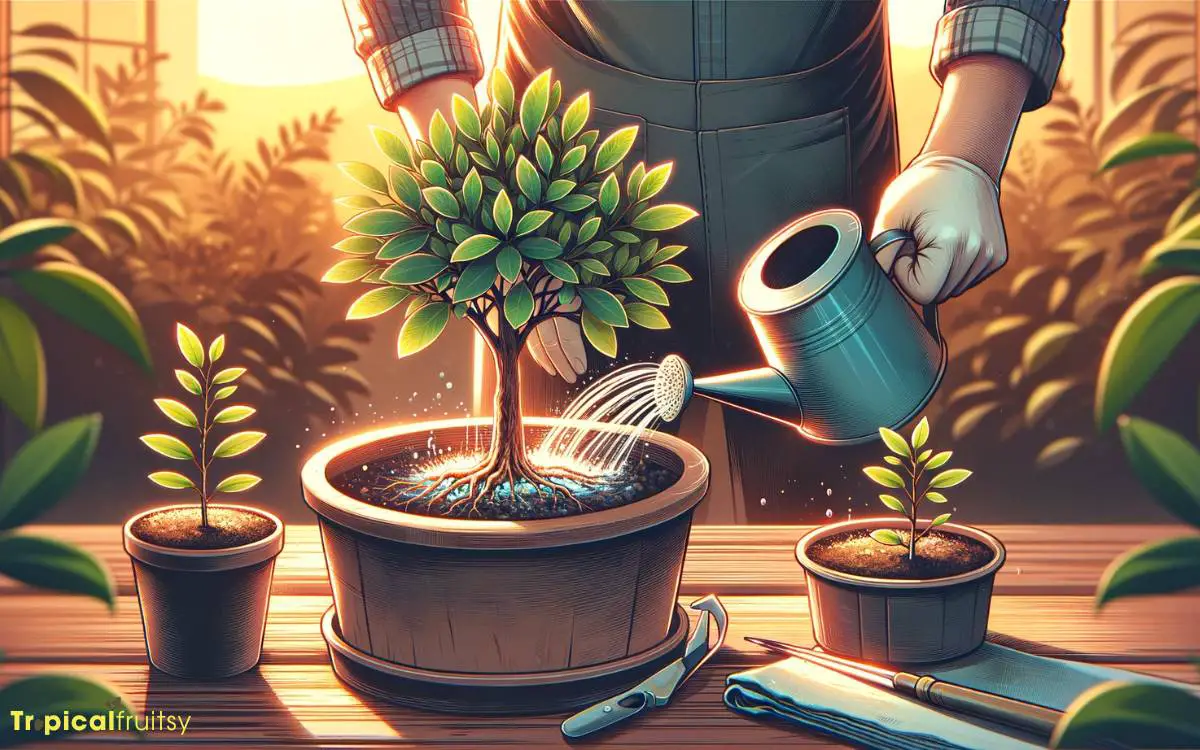
Once ackee saplings have established themselves, consistent care is crucial for their development into healthy, fruit-bearing trees.
A precise watering schedule must be adhered to, ensuring the young plants receive adequate moisture without becoming waterlogged.
In addition, understanding the saplings’ sunlight requirements and implementing proper pruning techniques are vital for promoting robust growth and preventing disease.
Watering Schedule
A consistent watering regimen is crucial for the healthy development of young ackee saplings, ensuring adequate moisture without causing waterlogging.
Here are key guidelines to follow:
- Water the saplings deeply but infrequently, promoting a strong root system. Aim for about once per week, adjusting for climate and soil conditions.
- Monitor the soil moisture regularly; it should be moist but not soggy. Use a moisture meter or the finger test—inserting a finger into the soil up to the second knuckle to feel for moisture.
- Reduce watering frequency as the saplings mature, fostering drought tolerance and further root development.
With the watering schedule well-managed, attention must then be turned to the saplings’ sunlight requirements to ensure photosynthetic efficiency and growth.
Sunlight Requirements
The appropriate amount of sunlight is essential for the growth of ackee saplings, with young plants requiring full sun to partial shade to thrive. Ideally, saplings should receive at least 4 to 6 hours of direct sunlight daily.
This exposure is critical for photosynthesis, the process by which plants convert light energy into chemical energy to fuel growth and development.
While mature ackee trees are quite tolerant of varying light conditions, young saplings are more sensitive and benefit from consistent light.
It is important to ensure that the light is not overly intense, which can cause stress and damage to the delicate foliage.
A balance of direct and filtered light will accommodate the sapling’s acclimatization to its environment, setting a robust foundation for future growth.
With proper sunlight established, attention must then be turned to implementing strategic pruning techniques to further shape and strengthen the developing ackee tree.
Pruning Techniques
While ensuring young ackee saplings receive adequate sunlight is crucial for their development, it is equally important to employ proper pruning techniques to promote a strong, healthy structure and facilitate optimal fruit production.
Pruning should be performed with precision and understanding of plant physiology to ensure the best outcomes.
Here are key pruning practices for young ackee saplings:
- Selective Removal: Thin out crowded branches to improve air circulation and light penetration, which reduces the risk of fungal diseases and encourages even growth.
- Formative Pruning: During the sapling stage, shape the tree by removing competing leaders and promoting a single, robust trunk.
- Maintenance Pruning: Annually remove dead, damaged, or diseased wood to maintain plant health and vigor, ensuring the tree’s resources are directed towards productive growth.
Can I Grow My Own Ackee Fruit to Use in the Preparation Process?
Yes, you can grow your own ackee fruit to use in the preparation process. To grow ackee fruit, follow these prepare ackee fruit steps: Plant seeds in well-drained soil, water regularly, and provide plenty of sunlight. With patience and proper care, you can enjoy your own home-grown ackee fruit.
Step 4: Troubleshooting Common Growth Issues
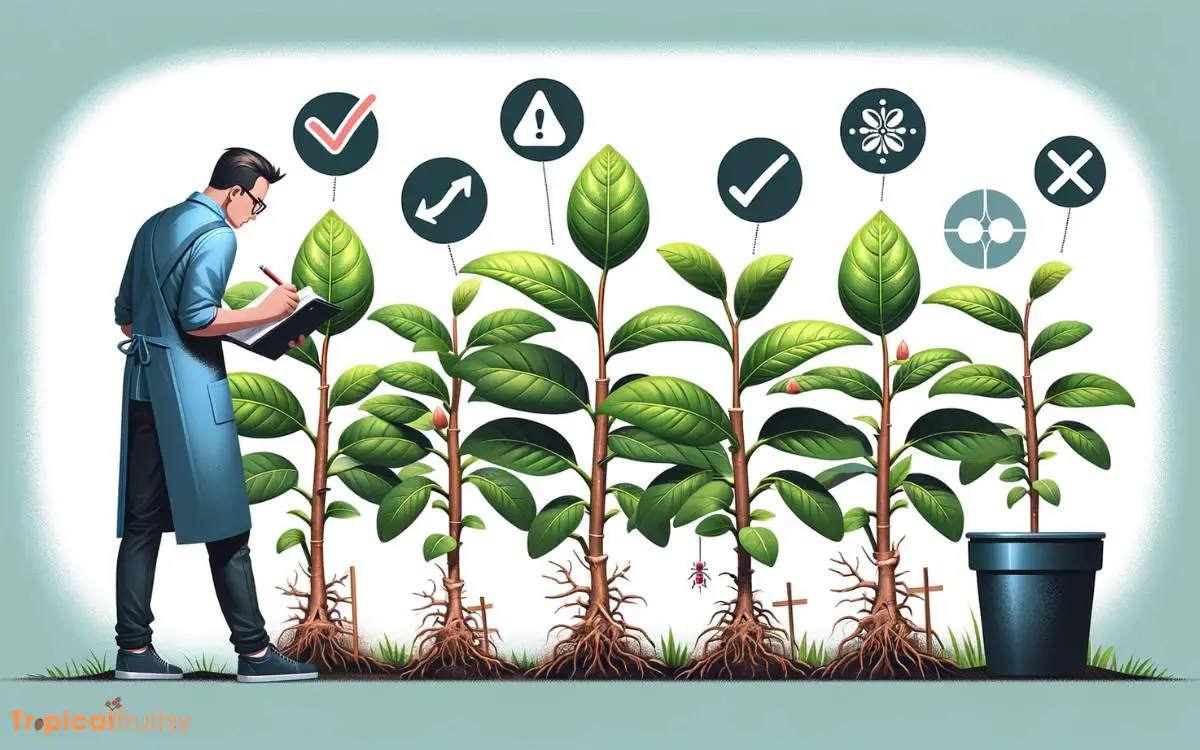
Despite optimal care, ackee seedlings may encounter growth challenges that require prompt identification and corrective measures.
Common issues include:
- Poor germination rates, which may be due to seed dormancy or hard seed coats impeding water absorption. Stratification or scarification techniques can enhance germination.
- Post-germination, seedlings may exhibit stunted growth or chlorosis, often indicative of nutritional deficiencies or poor soil pH balance. Employ soil testing to adjust fertilization and pH levels methodically.
- Additionally, damping-off, a fungal condition, can threaten seedlings. This necessitates sterile soil mediums and adequate air circulation to mitigate risks.
- Pests such as aphids and mites may also afflict ackee seedlings, requiring vigilant monitoring and potentially the use of appropriate, targeted biological or chemical controls.
Conclusion
The successful cultivation of ackee from seed represents a harmonious convergence of meticulous preparation and environmental conditions.
By ensuring quality seeds, optimal soil composition, and vigilant care, one facilitates a microcosm where the ackee sapling can thrive.
This process not only yields the luscious fruit but also embodies the broader principle of growth through patient and informed nurturing—mirroring the fruitful rewards of dedication in various facets of life.


